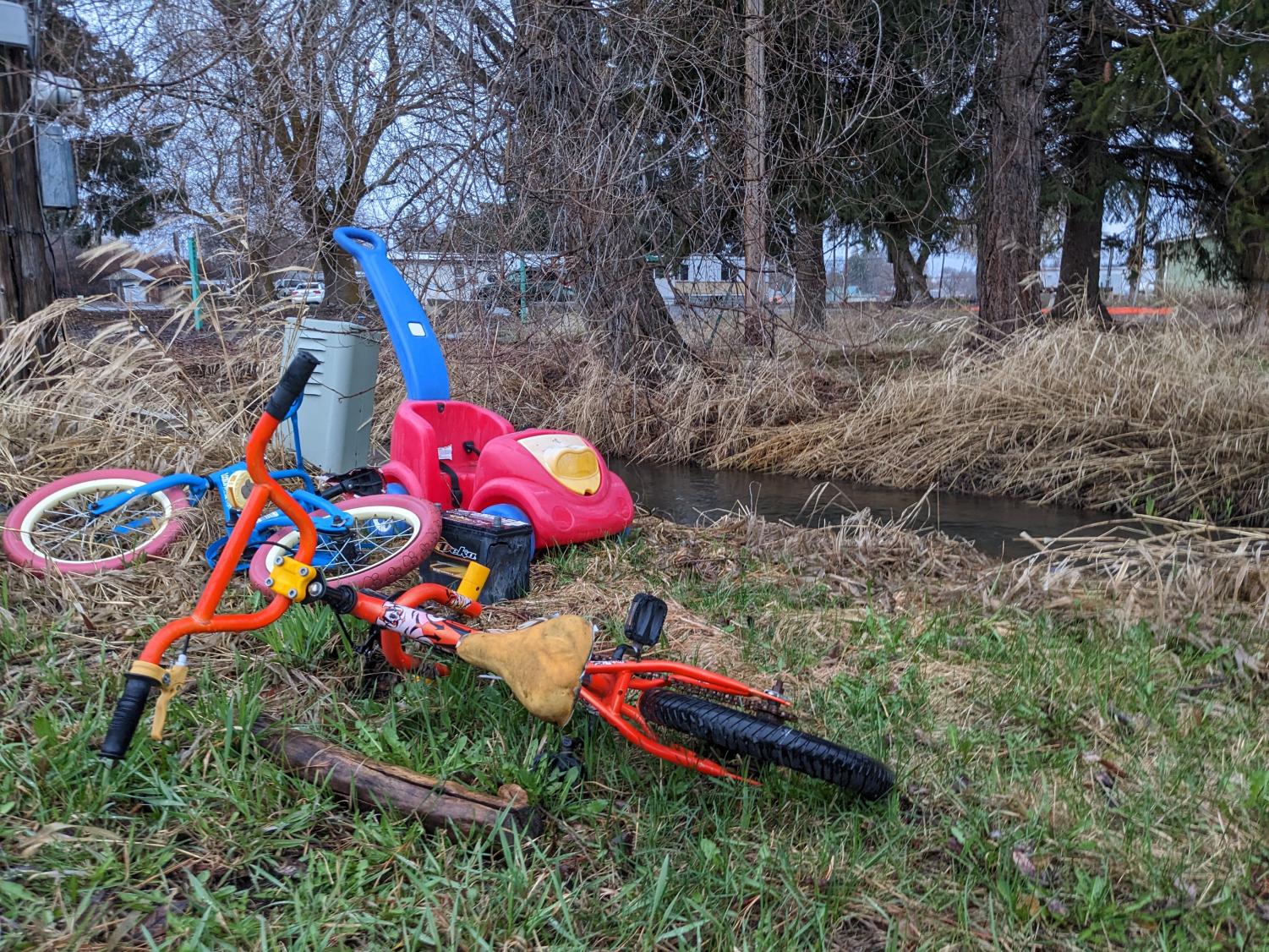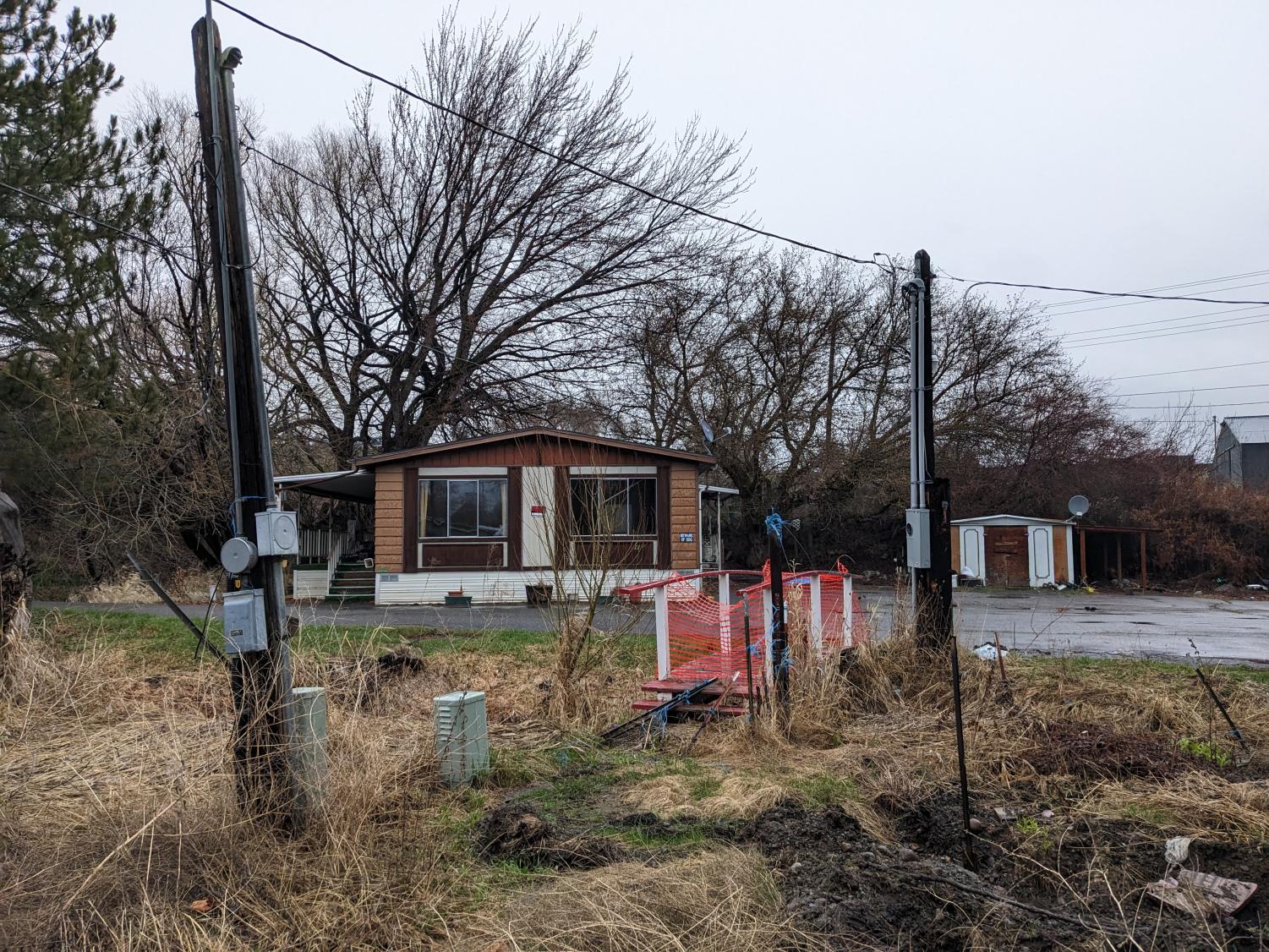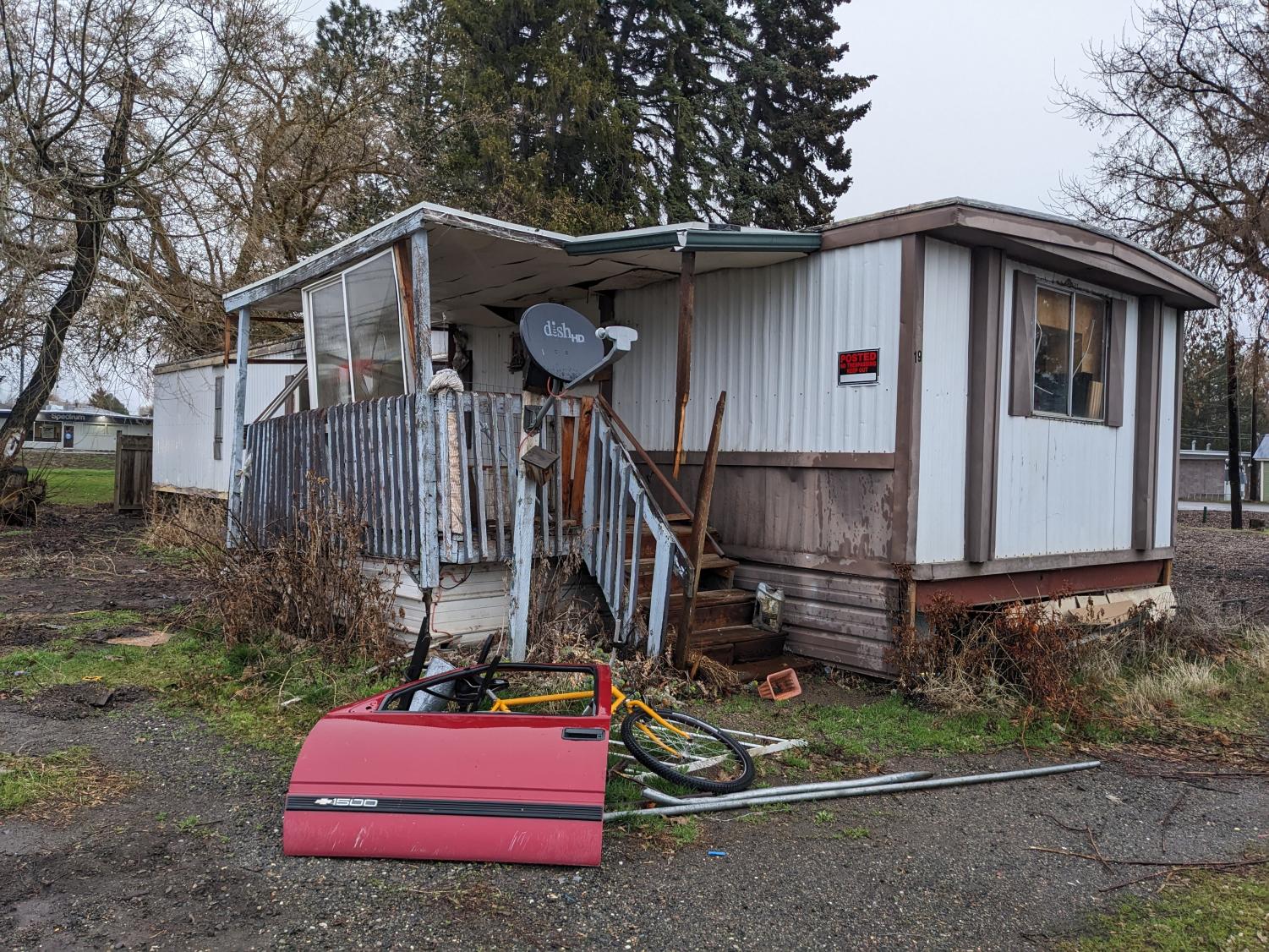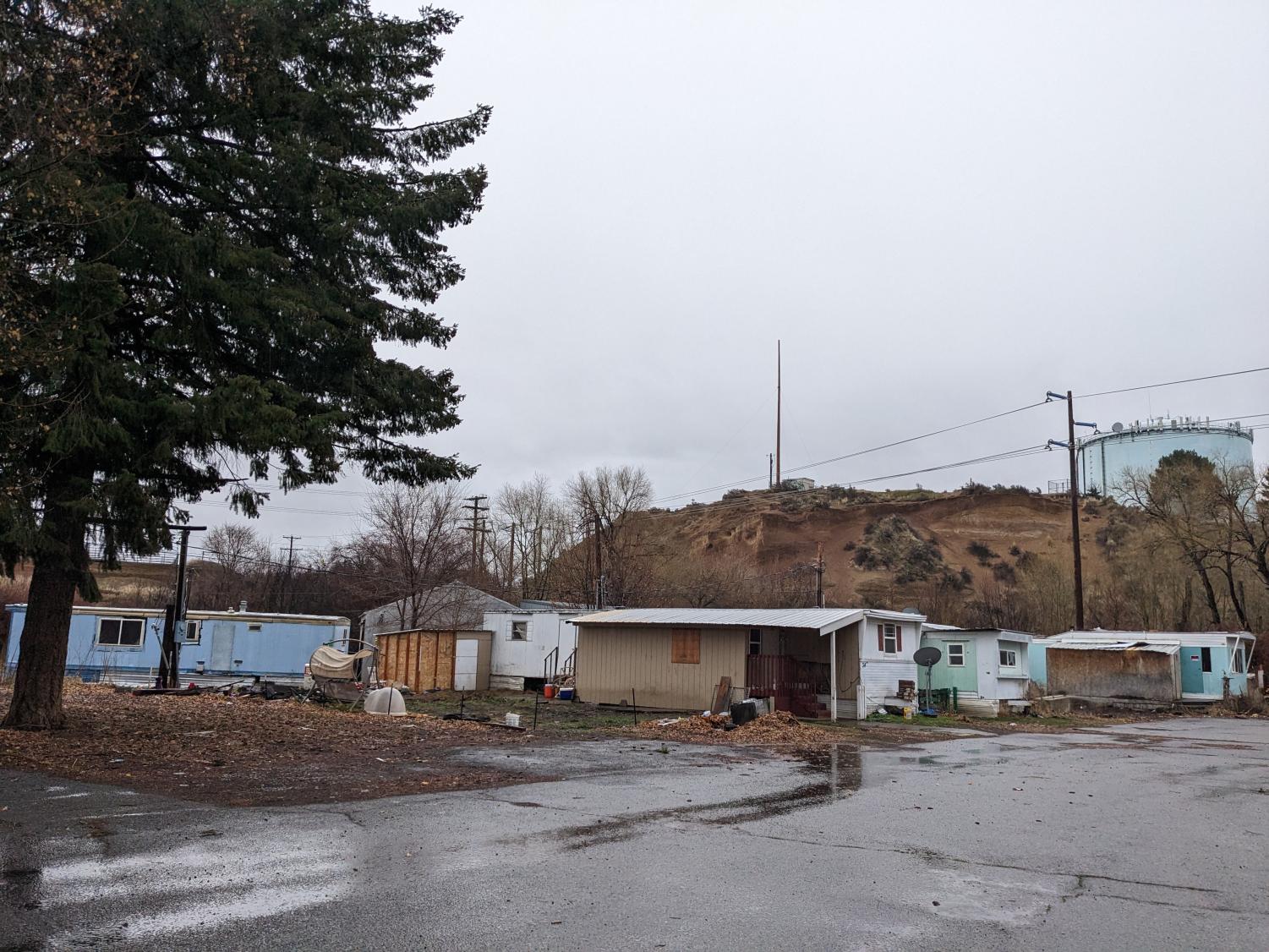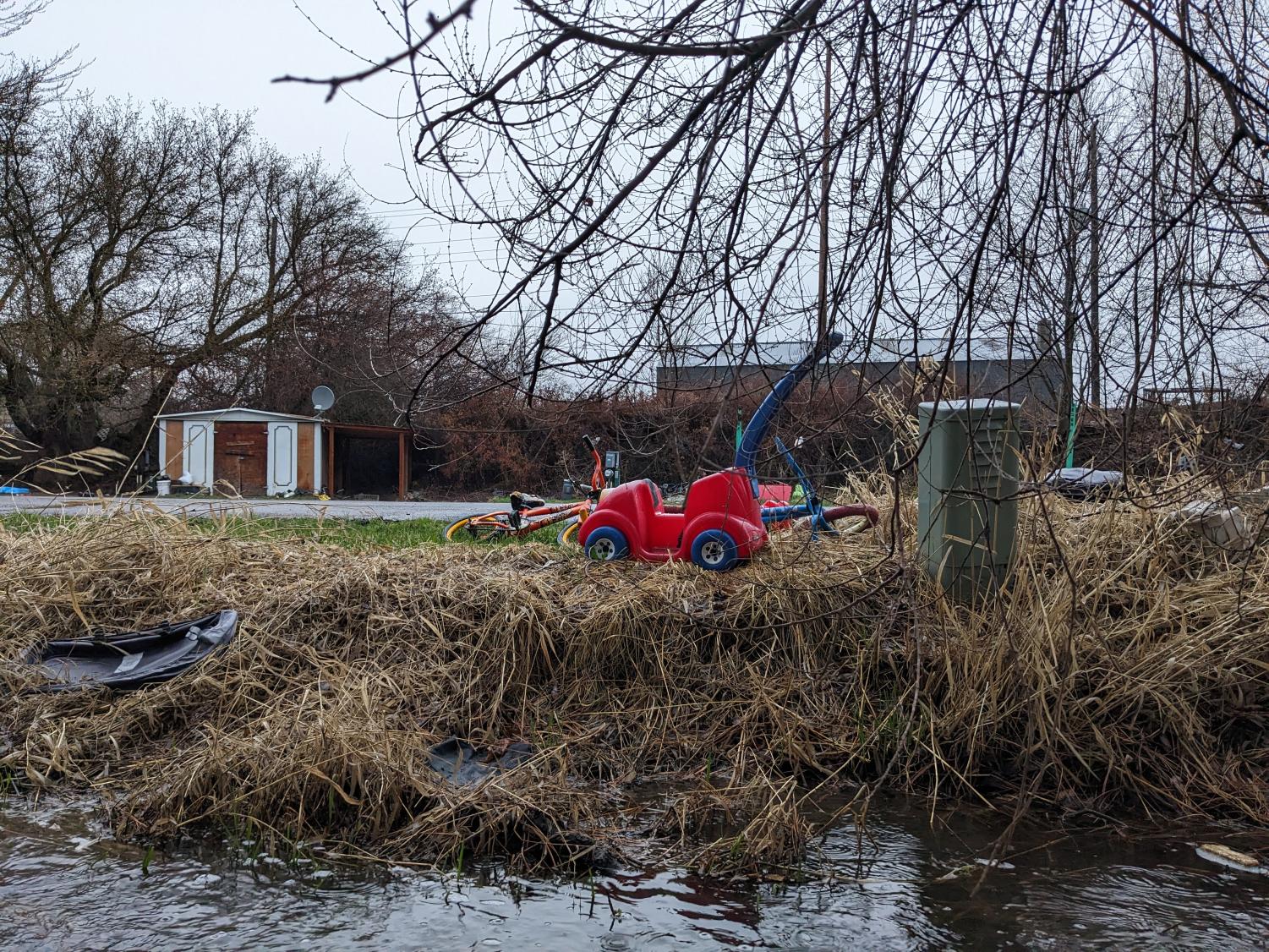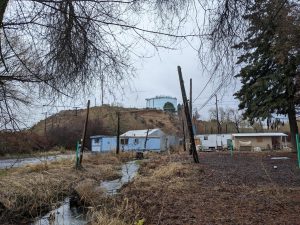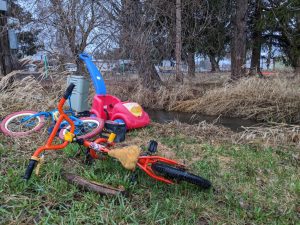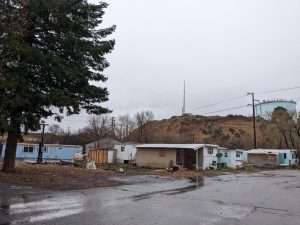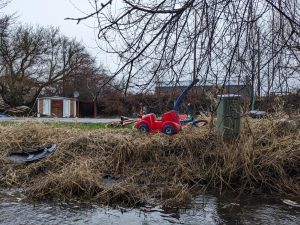Remembering Shady Acres: the once ‘peaceful,’ affordable community to be covered by Kittitas County Event Center expansion
Carlos Huitron and daughter Guadalupe Huitron-Lilly embraced for warmth outside the Kittitas County Courthouse building before holding a demonstration. Photo by Rob Fraser
April 12, 2023
A historic fight for Shady Acres: a battle spanning half a decade
Rows of abandoned trailers with colorful yet lifeless children’s toys scattered across the yards sit vacant where a community once thrived in the Shady Brook Mobile Park Home, also known as Shady Acres, on University Way across from Dairy Queen in Ellensburg.
“Sometimes I still wake up and I ask myself, where am I? I’m not in my trailer,” former Shady Acres resident of nearly two decades who was evicted from her home, Margarita Huitron, said. “It felt like they threw a bucket of cold water on us. It hurts us a lot.”
Shady Acres was a mobile home community of primarily immigrant families that held 34 homes, 24 owned and 10 rented, according to a census taken by the Shady Acres Homeowners Association (SAHA) in 2016, provided by former Shady Acres resident and daughter of Margarita, Guadalupe Huitron-Lilly. 66 adults and 59 children resided there at the time of the acquisition, nearly an even split between minors and adults.
The lot was subject to a polarizing legal battle in 2019 between SAHA and Kittitas County, Corp. after the county announced they were hoping to purchase the Shady Acres lot as part of the expansion of the Kittitas County Event Center detailed in their 2016 “Kittitas Valley Event Center Master Plan.”
The county’s plan was controversial, and prompted protests, County Commissioner and community meetings, petitions and a visit from Gov. Jay Inslee in 2016. It also led to a court case between SAHA and Kittitas County, in which the judge ruled in favor of Kittitas County.
The Observer spoke to former Shady Acres residents who were evicted, including Guadalupe and her parents, Carlos and Margarita, as well as former resident Ron McClelland. The Observer also spoke with CWU faculty involved in the battle for Shady Acres, including former Museum of Culture and Environment (MCE) Director Mark Auslander, current MCE Director Hope Amason and NW Expressive Arts Response founder and former CWU lecturer Nan Doolittle.
The chronological cause for Shady Acres
Community members testified at a series of meetings in defense of Shady Acres. One such community member, Cheryl Cox, said at a public meeting in June 2016: “You’re taking them [Shady Acres residents] away from being multigenerational in this community … I’m fortunate to be a fourth generation American citizen whose family crossed over from the other side on a boat, signed their name and moved on. Why can’t these people do that? Why are they different? They’re no different from anybody from Yugoslavia, Croatia, Austria … my family never left Roslyn, they kept their friends. That’s community.”
The 2016 “Kittitas Valley Event Center Master Plan” stated: “The County has made an offer on [Shady Acres] and is currently conducting due diligence on the condition of the site and the assistance that would be necessary and appropriate to relocate the low-income tenants.” Sources expressed concern that this intention was not fully actualized.
“I don’t think there was a complete understanding of how it would be to be from a different country, from a different culture, and have created this incredible neighborhood,” Doolittle said. “It was culturally supporting to that community.”
According to Carlos and Margarita, former owner of the property Jerrold “Jerry” Barton had claimed that he would give multiple years of advance notice if residents were to be evicted, and the Huitrons did not feel this expectation was honored.
“Jerry did not give any notice when he sold the property, so Shady Acres found out when the Ellensburg Daily Record ran a story [in 2016],” Guadalupe said.
Auslander was moved to action after the first Daily Record article broke the story that the park was to be sold in April 2016, so he sent an email to over 100 community members and organized a meeting at the Methodist Church in Ellensburg in April.
At this meeting, Guadalupe connected with Auslander, Amason, Doolittle and other community members. These meetings eventually led to the forming of SAHA and the filing of a court case with help from the Northwest Justice Project. In 2018, Kittitas County was removing and demolishing mobile homes that were vacant while many residents still lived in the park, which prompted lawyers at the Northwest Justice Project to speak out in opposition of this.
On Feb. 14, 2019, a trial took place in which the Northwest Justice Project alleged that Kittitas County violated the Fair Housing Act in the acquisition of Shady Acres.
According to an article published by The Daily Record on March 16, 2019, Judge Rosanna Malouf Peterson ultimately dismissed the case.
According to Auslander, the judge ruled in agreement with Kittitas County’s general counsel, claiming that there was no immediate harm done to the Shady Acres community since the lot had not yet been evacuated, despite testimonies presented claiming that home and property care in the community was declining as residents worried their investments would never pay off, also disregarding the potential mental turmoil caused as a result of the impending evictions.
“Of course, this was ludicrous,” Auslander said of the ruling. “These families were living under threat of imminent eviction. It wasn’t just a question of individually housing people, but the fact that it was a mutually self-sustaining, nurturing community that was being misrepresented … as a drug-filled den of criminality.”
Auslander claimed that help from the Northwest Justice Project allowed residents five years before their eviction was finalized; their final move out date was in Aug. 2022, and the closure of the park happened in Dec. 2022.
A general contractor evaluated the homes of Shady Acres at the request of the Plaintiff and estimated that “a Shady Acres resident would incur $12,200 for all of the costs involved in relocating a single-wide mobile home to a new location and a total of $16,800 to relocate a double-wide mobile home … The cost of moving many of the mobile homes at Shady Acres exceeds the fair market value of the homes, often by more than double … only two of the privately-owned mobile homes at Shady Acres would retain any value if moved.”
The Kittitas County Board of Commissioners announced plans to offer $6,000 compensation to evicted Shady Acres residents, less than half of what it would cost to relocate one of these homes.
According to Guadalupe, her parents received the $6,000 payment from the county, and it is her understanding that other residents also received the money, however she is unsure if some residents received less than others. She expressed confusion about how the county arrived at this figure.
“Shady Acres residents were also encouraged to apply for funding from the Department of Commerce through the Manufactured/Mobile Home Relocation Assistance Program,” Guadalupe said. “This program gave residents additional assistance based on the size of their homes. However, I do know that not all residents were able to receive this assistance because they did not meet income guidelines, meaning their income was above the threshold they set.”
A silent vigil and tree-planting ceremony was held in June 2016 to honor the Shady Acres community after the decision to sell the lot became public. Prayers were tied to a scarlet oak tree that was planted by residents and community members, according to coverage by The Daily Record.
One of these residents was Lily Ibarra, a then-8-year-old, who tied a note to the tree that read: “I will see you, every day,” as reported by The Daily Record. Ibarra’s note only rang true for five years until the residents had no choice but to abandon the lot.
According to Doolittle, conversations are currently in progress with the county about moving the scarlet oak tree to a city park in remembrance of Shady Acres, before the lot is demolished.
From the eyes of Shady Acres residents
What some community members referred to as an “eye-sore,” according to Guadalupe, was seen as a safe and beloved home by many families who dwelled there until they were legally obligated to vacate.
“I lived very happy there,” Margarita said. “We never had problems or issues with the police, no issues with the children, the parents or the adults.”
Guadalupe’s father, Carlos, mentioned with burden in his voice the significance of a stable and affordable housing option like Shady Acres.
“This was a place that charged rent cheaper,” Carlos said. “I realize that they bought the land to make their parties bigger, I understand that, but the owner who sold Shady Acres didn’t think about the impact on the community, and that was the only place that was affordable.”
Guadalupe spoke highly of the children who lived in the neighborhood and left a lasting impression on her.
“I have been thinking a lot about the children of Shady Acres,” Guadalupe said. “When I used to look at them, I would see myself and my brothers. I still do. I see all the possibilities that could be their lives.”
Ron McClellan was a resident of the park on and off since 1994 and had only positive remarks about his former home.
“It just became a home with neighbors who help, and that was one thing I really liked about it, because you got to meet your neighbors and it seems like everybody there was helpful,” McClellan said. “It was a nice community. Everybody was happy.”
McClellan recalled the “horrible” experience of being notified in 2016 that they would need to evacuate Shady Acres.
“It’s really shocking,” McClellan said. “What are we going to do now? Because even though my trailer was an older mobile home, you know, it needed work. But still, it was a home.”
McClellan reported facing financial insecurity and burden as a result of his eviction.
“I am on a fixed income,” McClellan said. “So it’s been very difficult now, when everything is sky high on prices. I’m paying almost $1,000 a month here and I’m in a studio apartment, not even a one bedroom … I don’t know how I’m going to be able to make it if it keeps going up. I’ve been accepted for a house from Habitat for Humanity, so that was a big relief for me. But again, we’re still stuck at the same problems, the cost of everything keeps going up.”
The Huitron family mentioned two older trees in the neighborhood that held special meaning to them.
“Outside our house, there were these two trees that provided a lot of shade, and in the summer, we used to have gatherings and invite a lot of neighbors,” Margarita said. “Even most recently before they closed down, we did one last gathering there in June. Now, we’re just communicating every now and then over the phone. It gave me a lot of sadness to have to leave there.”
Guadalupe recalled some of her memories in Shady Acres that also centered around these trees.
“Dad and those two trees outside, he used to hang a hammock when I would come and visit in the summer,” Guadalupe said. “He would hang it for me so I could sway under the trees and the neighbors would stop by to talk to me, and it was this little community within a community, everyone knew each other.”
Carlos said the shift has been “drastic” since their home was sold and residents were evicted.
“We had to come to Yakima,” Carlos said. “We lived at Shady Acres for about 20 years. It’s a very peaceful town. Sometimes I would go to the store and people would say ‘hello,’ not only within Shady Acres, but within Ellensburg. I go out now here, and nobody says hello to me.”
Guadalupe expressed the importance of ownership within her community.
“Whether it’s a mansion or whether it’s a trailer, the sense of ownership should not be diminished by it being one or the other in the sense of meaning that it has for the purchaser,” Guadalupe said.
Shady Acres was widely populated by immigrant farm workers and their children, according to Guadalupe.
“What is this telling us about the perception of the LatinX community in Kittitas County?” Guadalupe said. “Especially people like my father who came as a young man to work the lands in Ellensburg and then brought us to live here. He was the oldest male in his family, so he didn’t get to go to school to learn to read and write. Today, this same man has three children who together have earned three bachelor’s and two master’s degrees. My father did his best to provide us a safe home, just like all of the other parents at Shady Acres.”
Guadalupe continued: “Ellensburg in many ways is nice and welcoming, but in other ways there’s an undercurrent of inequality and racism that showed up with the commentary made about the purchase to justify the purchase. ‘The fairgrounds are historical, they’re cultural,’ but at the cost of another community that has a culture.”
Auslander, Amason and Guadalupe all mentioned that the county’s plans for the lot have fluctuated over time and lack clarity, and all reported that community members proposed using the Shady Acres space to house “swine” or other livestock for 4-H instead of being used for RV parking.
The Observer reached out to the Kittitas County Board of Commissioners for comment but did not receive a response prior to the time of publication.
An outpouring of community support
According to current Director of the MCE Hope Amason, the city of Ellensburg commissioned an external firm to do a housing survey of Ellensburg in 2017 and the results showed 0% occupancy rate in Ellensburg, so Amason and her colleagues were very aware of the threat looming over Shady Acres residents when they faced eviction.
The MCE hosted an exhibit featuring Mexican folk art in 2016, and one section of the exhibit served as a space for those impacted by the Shady Acres acquisition to create shrines and other crafts.
Amason, with the help of some of her Museum Studies students and Doolittle, offered childcare to Shady Acres residents during their community meetings. Photographer Rob Fraser documented the Shady Acres community through photos, some pictured here, for a collection titled “Faces of Shady Acres.”
Doolittle spoke about her experience attempting to preserve Shady Acres and giving testimony at County Commissioner meetings.
“I would collect petition signatures at public events, many people made signs, residents and community members, saying ‘Salva Shady Acres’ which means ‘Save Shady Acres,’ and those would be at what is now Unity Park,” Doolittle said. “I also offered expressive arts at Unity Park and had a lot of participation from Shady Acres families.”
The Huitron family expressed gratitude for the help of community members in the fight for their homes.
“Thankfully, there were university professors that came together to help us get more time because they only wanted to give us a year,” Margarita said. “He [Auslander] helped to bring in the lawyers to help us get the permission to stay for five years.”
Auslander said that despite the loss of the Shady Acres lot, the experience brought out the power and goodness in their community.
“There was the most amazing transformation in the Shady Acres community,” Auslander said. “They came together, they knew themselves as a community, as a voice. It was life transforming.”
Auslander recounted the kindness of the people who lived there, who threw him a farewell party at a park in a wealthier area of town when he accepted a job out of state. He said they all shared a laugh about how they crossed cultural lines.
“A truly beautiful, life-giving, dynamic community was destroyed and scattered,” Auslander said. “I think of some of the remarkable young people, especially young women, who were tweens at that age, but who really became quite active in retrospect to vote, and so I’m trying to look for a few silver linings.”
Amason mentioned the significance of remembering Shady Acres and its place in Ellensburg.
“I’m here to support the community and to advocate for the community … and to use whatever resources I have to make sure that people know about Shady Acres,” Amason said. “Even though people had to move out, this is an important history now in Ellensburg, that this community existed and that they were important, that they cared about each other and that they are a part of who we are as a city.”
Doolittle mentioned the implications of displacing communities from their homes.
“Maybe the neighborhood itself wasn’t living up to the prevalent white standards of what housing should look like, but the people were living in houses that they could afford to create,” Doolittle said. “Unlike some of our neighborhoods in our county, which sort of feel exclusive and in its own little cell, this was very welcoming.”
Doolittle emphasized that this is not just a community of white people, and efforts to be inclusive of all families here are necessary.
“Other people live here, they love here, they work here,” Doolittle said. “They are our neighbors and we need to reach out … We need to hear their voices, and sometimes they don’t speak English. We need to remember that, so if we do send out questionnaires, we need to make sure the people they’re reaching can actually read and respond.”
Guadalupe said she hopes Kittitas County will continue working with Doolittle to relocate the memorial tree, and that leaders will find a way to address the lack of affordable housing in this area.
“What happened with Shady Acres is shameful and will forever taint the history of the fair and rodeo,” Guadalupe said. “There is absolutely no justification for removing individuals from their homes to provide additional parking for people that may not even be from Kittitas County … A recognition from county leaders that what they did was wrong would also be nice, but I don’t have high hopes for that.”
Video testimonies to KC Board of Commissioners:
Guadalupe Huitron: https://www.youtube.com/watch?v=xVFDvbsBjXk
Nan Doolittle: https://www.youtube.com/watch?v=SS-y8nXSxSs
Cheryl Cox: https://www.youtube.com/watch?v=VeLZ9lE2oMg
Kittitas Valley Event Center Master Plan:
SAHA v. Kittitas County, Corp court case: https://casetext.com/case/shady-acres-homeowners-assn-v-kittitas-cnty-corp






